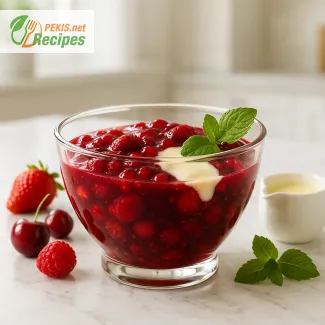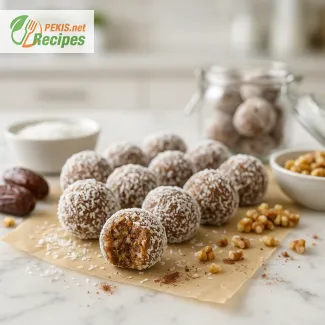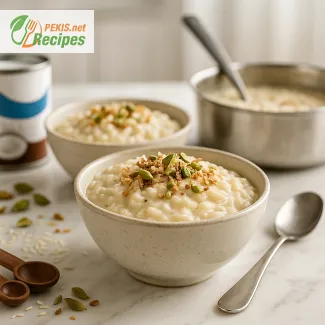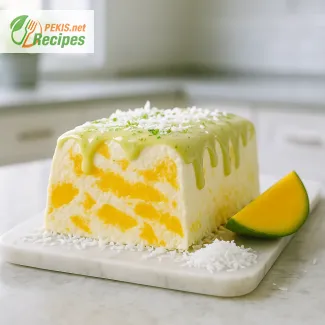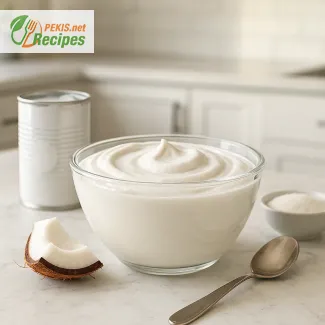Serves 4, ready in 15 minutes prep, 10 minutes cook, plus 3 hours chilling for the perfect set. Panna Cotta combines cream, milk, sugar, vanilla, and gelatin into a smooth, custard-like dessert finished with fresh berries and coulis. Light yet indulgent, it’s elegant for dinner parties, weddings, or family gatherings. Stores up to 2 days refrigerated or 2 months frozen, keeping its silky texture and delicate flavor intact.
PEKIS – professional chef and recipe developer with more than 25 years of experience, specializing in European and international cuisine. For this Panna Cotta, I’ve drawn on countless hours spent perfecting classic Italian desserts, working with fresh cream and seasonal berries to achieve that smooth balance between richness and lightness. My approach highlights how a few simple ingredients can be transformed into something truly elegant when treated with care.
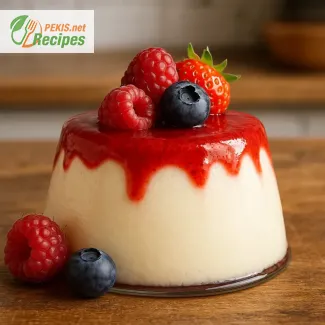
Authentic Italian Panna Cotta for Dessert Lovers
A silky smooth classic from Italy with a modern twist
Few desserts capture the essence of Italian elegance as perfectly as Panna Cotta. This delicate cream-based creation is known for its silky texture, gentle sweetness, and the ability to pair beautifully with a variety of toppings. The balance of cream, milk, sugar, and natural flavorings like vanilla or citrus zest results in a light yet indulgent dessert that feels luxurious but is surprisingly easy to prepare. When served with fresh berries or a berry sauce, it becomes a showcase of both visual appeal and taste harmony, making it a centerpiece for gatherings and refined dinners alike.
Historical background and culinary tradition
Originating in the Piedmont region of Northern Italy, Panna Cotta literally translates to “cooked cream.” Traditionally, it was crafted by gently warming sweetened cream with gelatin, creating a custard-like dessert without the heaviness of egg yolks. Over the centuries, this recipe spread across Europe and beyond, becoming one of the most beloved Italian desserts. Its adaptability allowed chefs to experiment with toppings, from fruit coulis to chocolate sauces and even aromatic herbs like basil or rosemary, which pair surprisingly well with the cream base.
Why this dessert stands out
- Velvety texture that melts in the mouth
- Versatile flavor base suitable for fruits, caramel, or chocolate
- Visually stunning presentation with layered sauces or garnishes
- Simple preparation with ingredients available in most kitchens
- Elegant and timeless – perfect for dinner parties, weddings, or casual family meals
Ingredients and their role
The beauty of this dessert lies in the harmony of its few key elements:
- Cream and milk provide a silky foundation, rich yet light.
- Sugar balances natural acidity in berries and enhances flavor.
- Gelatin ensures the perfect set—firm enough to hold, yet tender to the spoon.
- Vanilla or citrus zest infuses depth and aromatic complexity.
- Berry sauce or coulis introduces a refreshing contrast with its tart-sweet profile.
This composition is why Panna Cotta with berry sauce remains a universally appreciated dessert across cultures.
Storage and make-ahead tips
One of the reasons Panna Cotta has become a favorite is its practicality:
- At room temperature it can stay fresh for up to 2 days (covered).
- In the refrigerator, it remains perfect for 3–4 days.
- It can be frozen for up to 2 months, though the texture may soften slightly upon thawing.
- If served with a baked fruit topping or caramel, reheat gently at 150 °C for 8–10 minutes before serving.
Creative variations to inspire your table
- Coffee Panna Cotta – Infuse the cream with espresso for a bold, mocha-like flavor.
- Coconut milk Panna Cotta – A lighter, dairy-free alternative with tropical undertones.
- Matcha green tea Panna Cotta – Earthy and slightly bitter, pairing beautifully with white chocolate drizzle.
- Layered Panna Cotta – Combine vanilla cream with mango or raspberry purée for a two-tone effect.
- Caramel-topped Panna Cotta – Replace the berry sauce with a glossy caramel layer for a crème-caramel style twist.
Related culinary inspiration
For those seeking to explore even more variations of this timeless dessert, discover this guide: Panna Cotta with Berry Sauce: Italian Dessert
Why you will love this recipe
- Easy to prepare ahead of time
- Adaptable to any season with different toppings
- Luxurious taste with minimal effort
- A showstopper dessert that feels restaurant-quality
- Light yet satisfying, perfect after rich meals
Italian dessert culture and modern adaptations
Panna Cotta is more than just a dessert—it embodies the Italian culinary philosophy of simplicity, balance, and authenticity. Its presence on menus worldwide shows how traditional recipes can remain relevant while embracing contemporary flavors. The dessert’s adaptability makes it equally suitable for classic Italian feasts and modern global dining trends, bridging tradition and creativity in every serving.
- Soak the gelatin sheets in cold water for 5 minutes to soften. If using powdered gelatin, sprinkle it over 3 tbsp of cold water and let it bloom.
- In a saucepan, gently heat the heavy cream, milk, and sugar over medium heat. Stir until the sugar is dissolved, but do not allow the mixture to boil.
- Split the vanilla bean, scrape the seeds, and add both seeds and pod to the mixture. For extract, add it once the pan is removed from heat.
- Remove from heat, discard the vanilla pod, and stir in the softened gelatin until completely dissolved.
- Add lemon zest for a fresh note and mix well.
- Pour the mixture into serving glasses or ramekins. Allow to cool slightly before transferring to the refrigerator.
- Chill for at least 3 hours until fully set.
- Before serving, top each portion with berry sauce and fresh mixed berries for garnish.
FAQ questionWhat’s the right gelatin ratio for a silky set?
For a gentle wobble, aim for about 1–1.2% gelatin relative to the total liquid. In practice, that’s 7–9 g gelatin for ~700 ml (cream + milk). For unmolding with cleaner edges, go a touch firmer at 1.3–1.5%. Too much gelatin leads to a rubbery texture, too little to a loose set.
FAQ questionHow do I bloom gelatin correctly (powder or sheets)?
Sprinkle powdered gelatin over cold water (5× its weight) and let it bloom 5–10 minutes. For gelatin sheets, soak in ice-cold water 5–10 minutes, then squeeze dry. Stir bloomed gelatin into the hot but not boiling cream mixture until fully melted. Do not boil gelatin—high heat reduces its setting power.
FAQ questionWhy did my panna cotta turn grainy or rubbery?
Graininess comes from overheating (scalding or boiling) or undissolved gelatin; strain through a fine sieve to fix texture. Rubberiness signals too much gelatin or over-chilling in a very cold spot. Keep the mix below a simmer, use the correct ratio, and chill slowly, level, and covered.
FAQ questionCan I make panna cotta without gelatin?
Yes—use agar-agar. For a soft, custard-like set, use 3–4 g agar powder per ~700 ml liquid. Simmer 1–2 minutes (agar must boil briefly to activate), then pour and chill. Expect a cleaner, slightly brittle set versus gelatin’s creamy wobble. For dairy-free, pair coconut cream with agar for body and flavor.
FAQ questionHow do I unmold cleanly without cracks?
Lightly oil the molds, chill until fully set, then dip the mold in warm water for 5–10 seconds. Run a thin knife around the edge and invert onto a cold plate. If it resists, repeat the warm-water dip briefly—avoid prolonged heating, which can melt the edges.
FAQ questionWhat are the best dairy-free or lighter substitutions?
For dairy-free, use full-fat coconut cream plus a neutral plant milk (soy or almond) and either agar-agar (3–4 g/700 ml) or +1–2 g extra gelatin to compensate for lower fat. For lighter dairy, swap part of the cream with whole milk or evaporated milk; add a touch more gelatin to maintain the silky set.
FAQ questionHow do I keep the berry sauce from bleeding or sinking?
Cool the coulis completely before spooning over a fully set panna cotta. For layered desserts, let the first layer partially set (15–20 minutes), then add a thickened coulis (stabilize with 1–2 g gelatin per 200 ml or a brief cook with cornstarch). This keeps layers clean and flavors distinct.
Few desserts showcase the elegance of Italian cuisine as beautifully as Panna Cotta. Its silky smooth texture, gentle sweetness, and adaptability to countless toppings make it a timeless favorite. Whether served in simple glasses with fresh berries or unmolded on a plate with glossy coulis, it always delivers an impression of refinement with minimal effort.
The magic lies in the harmony of cream, milk, sugar, and vanilla, balanced by just the right amount of gelatin. This creates a dessert that is both light and indulgent, offering richness without heaviness. Each spoonful feels luxurious, yet approachable enough to prepare in any kitchen.
What makes Panna Cotta stand out is its versatility. It can be dressed with caramel, chocolate, or fruit sauces, layered for a modern presentation, or adapted with plant-based alternatives for a dairy-free version. It easily transitions from a family meal to a wedding banquet, proving that true culinary classics never lose relevance.
With a preparation time that is short, storage that is convenient, and a flavor profile that is universally loved, Panna Cotta continues to hold its place among the most celebrated desserts worldwide. Its enduring popularity confirms its role as a symbol of Italian culinary tradition, bringing together simplicity, elegance, and taste in every serving.
Allergens present in the recipe:
- Milk (dairy)
- Gelatin (animal-based product)
Gluten: This recipe does not contain gluten.
Substitution tips for allergens and gluten:
- Replace dairy cream and milk with coconut cream and almond milk for a lactose-free version.
- Use agar-agar powder instead of gelatin for a vegetarian alternative.
- Vitamin A: 380 mcg – supports vision and immune function
- Vitamin C: 15 mg – boosts collagen production and immunity
- Calcium: 120 mg – essential for strong bones and teeth
- Potassium: 200 mg – supports heart health and muscle function
- Magnesium: 18 mg – contributes to energy metabolism and nerve function
- Anthocyanins 80 mg – protect against oxidative stress and support cardiovascular health
- Flavonoids 50 mg – help reduce inflammation and improve blood circulation
- Vitamin E 1.2 mg – supports skin health and acts as an antioxidant
